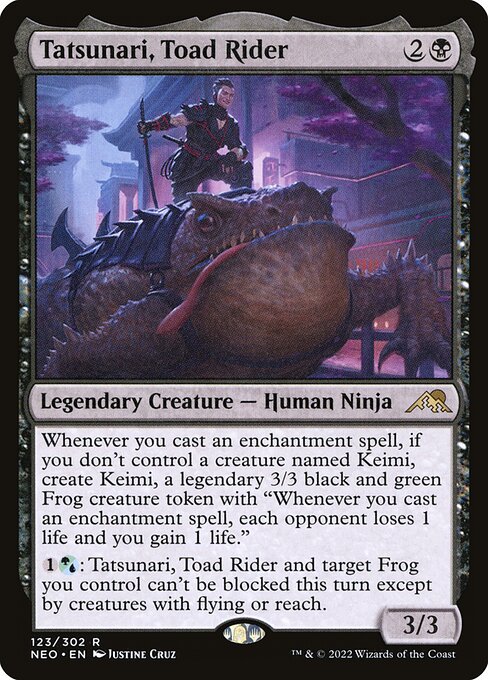
Image courtesy of Scryfall.com
Set-Level Rarity Trends in Kamigawa: Neon Dynasty
Visualizing how rarity behaves across a single set is a little like mapping a city at night: the glow points you toward the archetypes Wizards of the Coast wants you to explore, while the dim corners reveal where power-level gaps invite new strategies. Kamigawa: Neon Dynasty leans into a modern design language that blends legendary characters, ninja cunning, and enchantment-led synergies 🧙🔥💎. Tatsunari, Toad Rider sits squarely in the rare tier, a choice pick for players who love tempo, token generation, and multi-color interplay. Its presence in the set isn’t just about its own stats; it’s about how a rare card can anchor a narrow but explosive enchantment-focused plan that scales with the surrounding card pool ⚔️🎨.
Tatsunari at a Glance: The Card, The Color Identity, The Engine
- Mana cost: {2}{B} — a compact, splashy black starter that leaves room for ramp or flicker in multicolor shells.
- Type and stats: Legendary Creature — Human Ninja, 3/3. A solid body that punches above its weight in aggressive or midrange decks.
- Color identity: Color identity is B, G, U, reflecting a triad that enables graveyard-friendly, enchantment-heavy, and Frog-token themes.
- Oracle text highlights: When you cast an enchantment spell, if you don’t control a creature named Keimi, you create Keimi, a legendary 3/3 black/green Frog token with a potent anthem-like trigger: “Whenever you cast an enchantment spell, each opponent loses 1 life and you gain 1 life.”
- Unlock mechanic: {1}{G/U}: Tatsunari and target Frog you control can’t be blocked this turn except by creatures with flying or reach.
That combination—a robust evasive option for Tatsunari plus a token engine that feeds off your enchantments—highlights how Neon Dynasty balanced rarities with functional archetypes. The card’s ritual of birthing Keimi and nudging opponents toward life totals that care about life swing echoes the set’s overarching theme of dynamic, interactive combat. It’s a design that invites players to lean into tempo and value, all while painting a flavorful scene of ninjas, frogs, and neon-lit night markets 🎲🎨.
Rarity in a modern MTG set is less about “power per card” and more about “power per deck archetype.” Tatsunari’s rare slot is a signal card for enchantment-centric builds that pivot around Keimi’s token generation and the unblockable synergy with Frog creatures. In Neon Dynasty, a set that tilts toward legendary creatures and flavorful two-color or three-color identities, a rare like Tatsunari helps anchor蛙-token or enchantment subthemes without tipping into the expense tier of mythics. For collectors and players alike, this tends to translate into a stable, approachable market segment: the card is commonly accessible in nonfoil form with foil versions representing a moderate premium, a pattern confirmed by market data indicating a modest USD price and foil premium across platforms 🧙🔥💎.
Designers aren’t just balancing power; they’re balancing play patterns. Tatsunari’s trio of colors, its synergistic enchantment trigger, and its unblockability clause create a compact engine that rewards careful sequencing and board presence—an ideal example of how rarity bands can support distinct gameplay loops within a single set.
The heart of Tatsunari’s appeal lies in its ability to catalyze an enchantment-heavy strategy, while simultaneously offering a resilient threat that can push through with the right support. Keimi, the token that appears when you cast enchantments, isn’t just a cute addition—she amplifies the life-loss/life-gain dynamic that’s central to a number of Neon Dynasty enchantment themes. This kind of feedback loop—cast enchantments, spawn tokens, pressure opponents, and keep Tatsunari threatening defense—helps explain why the card occupies a rare slot with staying power in constructed formats and a reasonable niche in EDH/Commander circles 🧙🔥⚔️.
From a design perspective, Tatsunari also demonstrates how a single card can shape scarcity perception. Its multi-color identity (B,G,U) implies that players building three-color shells will naturally encounter it as a target in their booster draft or sealed pools. The rarity balance ensures that while this card is desirable for certain gameplay paths, it doesn’t bottleneck color-dense strategies or inflate the price of multiples in a single set run. In other words, it’s a deliberate spacing of power and accessibility that mirrors broader set-level trends across Neon Dynasty 🧪🎲.
- Enchantment synergy: Lean into a deck that casts a handful of enchantments to steadily produce Keimi tokens and drain life totals through the enchantment triggers.
- Frog/Token tempo: Use Tatsunari’s unblockable ability in tandem with Frog tokens to pressure the opponent while keeping blockers at bay.
- Color-constrained strategies: With B as the base color and G/U for splash, you can weave graveyard shenanigans, protection, and tempo plays into a single, tight plan that respects the set’s rarity curve.
Beyond gameplay, Tatsunari’s artwork—brought to life by Justine Cruz—adds aesthetic value for fans who adore Neon Dynasty’s neon-streaked aesthetic. The rarity designation, paired with a foil option, keeps it relevant for both players and collectors. Its EDHREC rank sits in a reasonable range for a niche Commander staple, reflecting its status as a flavorful, usable card rather than a universal staple. The price trajectory in nonfoil form tends to stay approachable for budget-focused players, with foil variants offering a more premium, collectible path 🧙🔥💎.
While you’re exploring set-level trends and brewing your Tatsunari-led deck, you can also take a small detour into personal gear that celebrates your hobby. The featured product below is a sleek Slim Lexan phone case for iPhone 16—perfect for keeping your device protected while you draft or stream your latest deck tech. A little real-world flair can make the MTG journey all the more enjoyable ⚔️🎨.